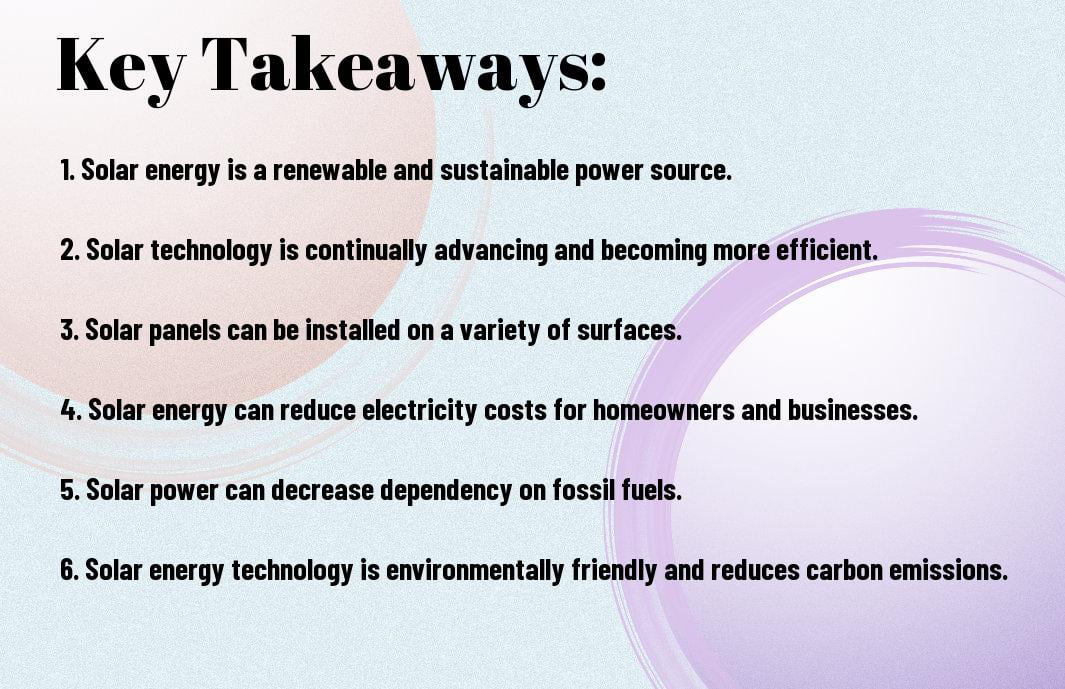Generating power from the sun is no longer a far-fetched idea, but a rapidly advancing technology with virtually limitless possibilities. The ingenious use of photovoltaic panels to harness the sun’s energy has transformed the way we think about electricity production. In this blog post, we will delve into the unprecedented opportunities that solar energy technology offers, from reducing greenhouse gas emissions and combatting climate change to providing a sustainable and secure energy source for the future. Join us as we uncover the revolutionary advancements and implications of this transformative energy source.
Key Takeaways:
- Solar energy technology is a sustainable and renewable source of power: By harnessing energy from the sun, we can reduce our reliance on fossil fuels and decrease carbon emissions, contributing to a cleaner and greener future.
- Advancements in solar technology have led to increased efficiency and affordability: Innovations in solar panels and energy storage systems have made solar power more accessible to a wider range of consumers, paving the way for widespread adoption.
- Solar energy has the potential to revolutionize the way we power our world: By embracing solar technology, we can create a more resilient energy infrastructure, promote energy independence, and mitigate the impact of climate change on a global scale.

The Science of Solar Energy
Some argue that the future of energy lies in the power of the sun. Solar energy technology continues to advance, providing a sustainable and renewable source of power. Understanding the science behind solar energy is crucial to harnessing its full potential.
Basics of Solar Power Generation
Energy from the sun is converted into electricity through the use of photovoltaic cells. These cells, usually made of silicon, absorb sunlight and generate direct current (DC) electricity. An inverter then converts this into alternating current (AC) electricity, making it suitable for use in homes and businesses. The amount of electricity produced depends on factors such as the intensity of sunlight and the angle at which the panels are installed.
Solar power generation has the potential to significantly reduce dependence on fossil fuels and lower carbon emissions. By capturing the abundant energy from the sun, we can create a more sustainable energy future. Understanding the basics of solar power generation is the first step towards embracing this clean and renewable energy source.
Advances in Photovoltaic Materials
Advances in photovoltaic materials have revolutionized the efficiency and cost-effectiveness of solar panels. Traditional silicon-based panels are being enhanced with new materials such as thin-film solar cells and perovskite solar cells. These materials offer higher conversion efficiencies and lower production costs, making solar energy more accessible to a wider audience.
Materials such as perovskite have shown great promise in increasing the efficiency of solar panels while reducing their weight and thickness. Researchers continue to explore novel materials that can further enhance the performance of photovoltaic cells, bringing us closer to a future where solar energy is the primary source of electricity worldwide.
Application of Solar Energy Technology
Residential and Commercial Use
Commercial and residential buildings can greatly benefit from the application of solar energy technology. By installing solar panels on rooftops or open land, businesses and homeowners can generate their own electricity and reduce their reliance on traditional energy sources. This not only lowers energy bills but also reduces carbon footprint, contributing to a more sustainable environment.
Moreover, many governments offer incentives and tax credits for installing solar panels, making it an attractive investment for both commercial and residential properties. With advancements in technology, solar panels have become more efficient and affordable, making it a viable option for a wide range of consumers.
Large-Scale Solar Power Plants
Powering entire communities or cities, large-scale solar power plants harness the energy from the sun to generate electricity on a massive scale. These plants consist of numerous solar panels spread across vast areas, capturing sunlight and converting it into usable energy for distribution across the grid.
Moreover, large-scale solar power plants are clean and renewable energy sources, significantly reducing greenhouse gas emissions and reliance on fossil fuels. They play a crucial role in building a more sustainable energy infrastructure for the future, ensuring a greener and more environmentally friendly society.
Solar power plants are a key component of the renewable energy sector, helping to meet growing energy demands while mitigating the impact of climate change. As technology continues to improve, we can expect to see even more large-scale solar projects powering cities and regions around the world.
Economic and Environmental Impact
When it comes to the discussion of solar energy technology, the economic and environmental impact cannot be overlooked. Solar energy has the potential to revolutionize the way we power our world, offering a clean and sustainable alternative to traditional fossil fuels.
Cost Trends and Incentives for Solar Adoption
Unlike in the past, the cost of solar energy technology has been steadily decreasing over the years. This trend has been driven by advancements in technology, increased production efficiency, and government incentives that promote the adoption of solar power. An increasing number of homeowners and businesses are finding that investing in solar panels can lead to significant savings on their energy bills in the long run.
Government incentives such as tax credits, rebates, and net metering programs further encourage the adoption of solar energy. These incentives not only make solar energy more affordable for individuals and businesses but also help reduce greenhouse gas emissions and reliance on non-renewable energy sources.
Carbon Footprint and Sustainability Considerations
For a sustainable future, understanding the carbon footprint and environmental impact of our energy choices is crucial. Solar energy stands out as a clean and renewable energy source that significantly reduces carbon emissions and environmental degradation. By harnessing the power of the sun, we can decrease our dependence on fossil fuels and mitigate the harmful effects of climate change.
For those concerned about sustainability, solar energy offers a promising solution. Solar panels have a long lifespan and are recyclable, making them a truly sustainable energy option. Additionally, the sun is an abundant and free source of energy, providing an endless supply of power without depleting natural resources.
The growth of solar energy technology represents a significant step towards a more sustainable and environmentally friendly future. Investing in solar power not only benefits individuals and businesses economically but also contributes to the preservation of our planet for future generations.
Challenges and Future Directions
Technological and Infrastructural Hurdles
Now, as we delve into the challenges facing the widespread adoption of solar energy technology, it becomes evident that there are significant technological and infrastructural hurdles that need to be addressed. One major technological issue is the efficiency of solar panels, which still have limitations in converting sunlight into electricity at a high rate. Additionally, the storage of solar energy poses a challenge, as current battery technology for storing solar energy needs improvement to ensure reliable power supply even when the sun is not shining.
An equally crucial infrastructural hurdle is the lack of proper grid integration for large-scale solar energy systems. Investments in upgrading existing grids and developing smart grid technologies are necessary to effectively distribute solar energy where it is needed most. Moreover, regulations and policies related to solar energy need to be streamlined to facilitate the deployment of solar technologies on a broader scale.
Innovations and Predictions for Solar Energy Expansion
On the forefront of overcoming these challenges are ongoing innovations and predictions for the expansion of solar energy technology. Advancements in photovoltaic technology, such as perovskite solar cells, show promise in enhancing solar panel efficiency and reducing manufacturing costs. Furthermore, the development of energy storage solutions like grid-scale batteries and hydrogen storage can address the intermittency of solar power and enable 24/7 renewable energy supply.
Hurdles in solar energy expansion can also be tackled with the integration of artificial intelligence (AI) and Internet of Things (IoT) technologies. AI algorithms can optimize solar energy production and grid management, while IoT devices can enhance monitoring and control of solar energy systems. These innovations pave the way for a future where solar energy plays a central role in our transition to a sustainable energy landscape.
Summing up
With this in mind, it is evident that solar energy technology possesses immense potential in transforming our energy landscape. By harnessing the power of the sun, we can reduce our dependence on fossil fuels, lower carbon emissions, and work towards a more sustainable future. Continued advancements in solar technology, coupled with increasing affordability and efficiency, make it a key player in the transition to renewable energy sources. Investing in solar energy not only benefits the environment but also offers long-term economic advantages. As we strive to combat climate change and secure a cleaner planet for future generations, exploring the potential of solar energy technology is crucial.
FAQ
Q: What is solar energy technology?
A: Solar energy technology refers to the harnessing and utilization of sunlight to generate electricity or heat. This technology includes solar panels, solar thermal systems, and concentrated solar power plants.
Q: How does solar energy technology work?
A: Solar energy technology works by capturing sunlight using photovoltaic cells or solar collectors. Photovoltaic cells convert sunlight directly into electricity, while solar collectors absorb sunlight to generate heat. This energy can then be used to power homes, businesses, or other applications.
Q: What are the benefits of exploring the potential of solar energy technology?
A: Exploring the potential of solar energy technology offers numerous benefits, including reducing greenhouse gas emissions, decreasing reliance on fossil fuels, creating jobs in the renewable energy sector, and promoting energy independence. Additionally, solar energy is a clean, renewable resource that can help combat climate change and increase sustainability.



